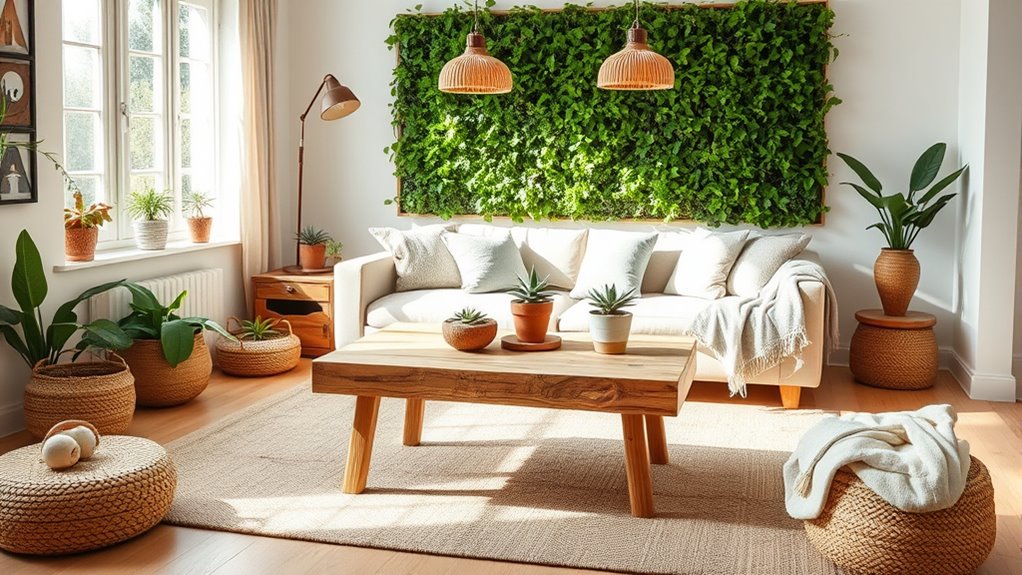To create an eco-friendly home décor, embrace natural fibers like cotton and linen for comfort and sustainability. Try upcycling old items, such as turning mason jars into unique vases. Improve energy efficiency by switching to LED bulbs and utilizing natural light. Opt for non-toxic paints that enhance air quality, and don’t forget to incorporate indoor plants to boost wellness and air purification. There’s so much more you can do to transform your space sustainably.
Key Takeaways
- Embrace natural fibers like cotton, wool, and linen for sustainable, breathable textiles in your home décor.
- Upcycle items like mason jars and teacups for unique, eco-friendly decor that minimizes waste.
- Switch to LED lighting to significantly reduce energy consumption and save on electricity bills.
- Use non-toxic paints and finishes to enhance indoor air quality and create a healthier living environment.
- Incorporate indoor plants to improve air quality, reduce stress, and add natural beauty to your spaces.
Embracing Natural Fibers in Home Decor
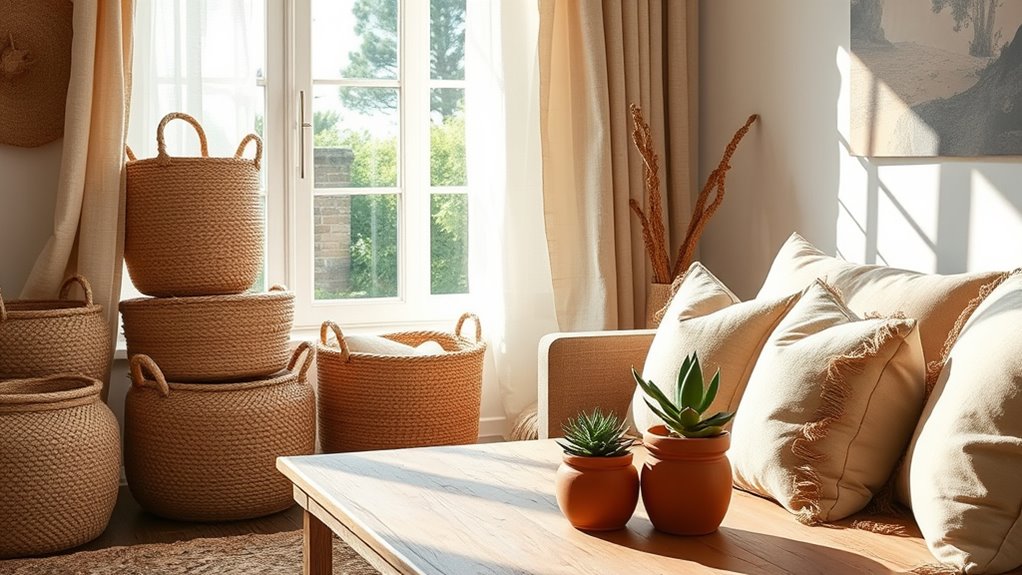
Natural fibers are making a comeback in home decor, and for good reason.
They’re eco-friendly, biodegradable, and sourced from renewable resources, making them a sustainable choice for your home. With options like cotton, wool, and linen, you’ll enjoy excellent breathability, perfect for cozy bedding and comfortable upholstery. Additionally, natural fibers require less energy for production, which further reduces their environmental impact. The use of renewable resources ensures that your home decor contributes to a sustainable lifestyle. Incorporating elements like natural materials enhances the overall aesthetic while promoting an eco-friendly ambiance. Moreover, natural fibers can also support biodiversity by encouraging the use of sustainable agricultural practices.
Plus, organic natural fibers are hypoallergenic, making them safe for sensitive skin. Their timeless aesthetic fits seamlessly into various decor styles, enhancing your space’s visual appeal. Durable materials like linen and wool mean you won’t need to replace items frequently, saving you money in the long run.
The Art of Upcycling and Repurposing
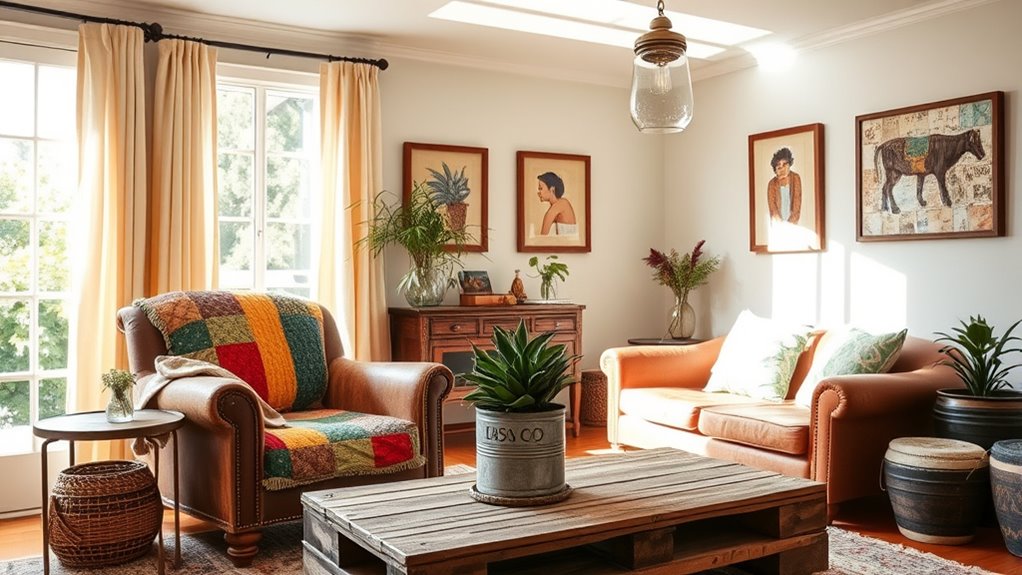
While many people discard items they no longer use, you can transform forgotten treasures into stunning decor through the art of upcycling and repurposing.
Consider turning old mason jars into lanterns or vases, adding a sustainable touch to your space. Repurpose teacups as candle holders for a warm ambiance or use wine bottles as unique vases. You can create coasters from wine corks to protect your surfaces while reusing materials. Mason jar lanterns can also be customized with fairy lights for an added touch of charm. To enhance the overall aesthetic, consider incorporating rustic lighting that complements your upcycled decor. Additionally, using eco-friendly materials in your projects can further minimize your environmental impact. Regular cleaning of your upcycled items, similar to preventing cross-contact in food safety, ensures they remain attractive and functional.
For furniture, reupholster an old chair with eco-friendly fabric or turn a vintage trunk into a coffee table. These projects not only reduce waste but also let you personalize your decor, making your home truly yours.
Enhancing Energy Efficiency With Lighting Choices
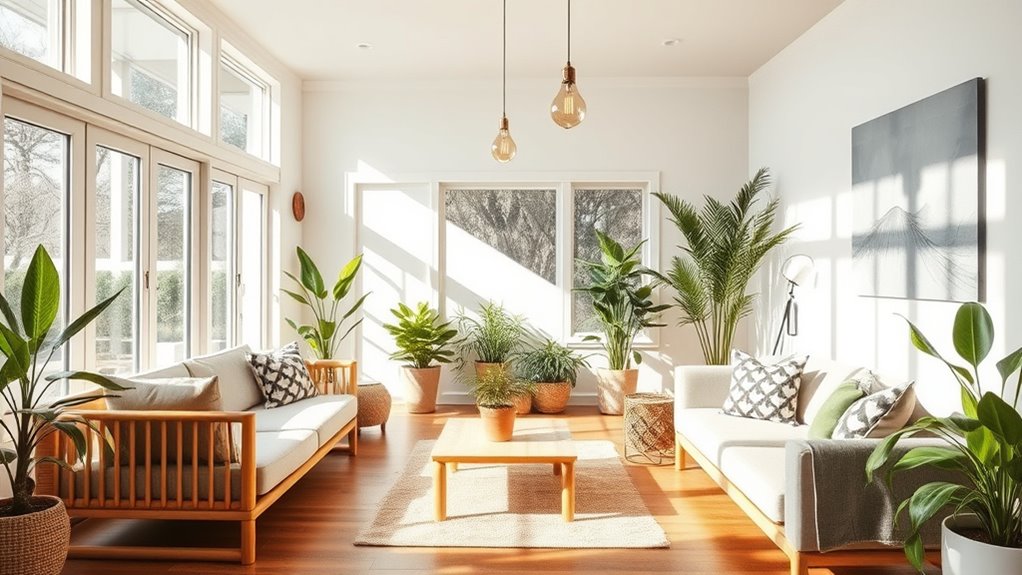
Choosing the right lighting can significantly enhance your home’s energy efficiency. By switching to LED bulbs, you can reduce energy consumption by up to 90% and save around $225 annually on energy costs.
Although LEDs may cost more upfront, their longevity and efficiency lead to long-term savings. Consider ENERGY STAR-certified products for guaranteed efficiency. Incorporating smart lighting solutions, like remote-controlled bulbs, allows you to minimize energy use when you’re not home. Additionally, adopting the one in, one out rule when managing décor can help maintain a clutter-free environment that maximizes the impact of your lighting choices. Using air purifiers can further enhance your indoor air quality, promoting a healthier living space alongside your lighting efforts. Furthermore, utilizing energy-efficient ceiling fans can enhance airflow, contributing to a more pleasant living environment.
Don’t forget about natural lighting; using mirrors and sheer curtains can amplify daylight, reducing reliance on artificial lights. For outdoor spaces, solar-powered lanterns and LED path lights offer eco-friendly illumination while cutting down on electricity costs. Additionally, natural fiber rugs can complement your lighting choices by adding warmth and texture to your space.
Embrace these lighting choices for a more sustainable home.
Choosing Non-Toxic Paints and Finishes

Choosing non-toxic paints and finishes is vital for improving indoor air quality. Non-toxic paints are free from harmful chemicals like VOCs, heavy metals, and biocides, reducing health risks such as respiratory issues and headaches. Brands like ECOS Paint, AFM Safecoat, and Healthier Homes offer excellent VOC-free options. Look for certifications like Green Seal to ensure you’re selecting eco-friendly products. You’ll also find biodegradable options, like those from The Real Milk Paint Co., made from organic milk protein. Many of these brands prioritize sustainable production practices, ensuring that their products are not only safe for your home but also better for the planet. Additionally, selecting paints with high-quality content can further enhance indoor air quality and overall safety. Using paints with antimicrobial properties can also help maintain a healthier living environment by reducing the risk of mold and bacteria growth. Furthermore, choosing paints from brands that focus on energy monitoring features can contribute to a more eco-friendly home.
Incorporating Indoor Plants for Wellness and Air Quality
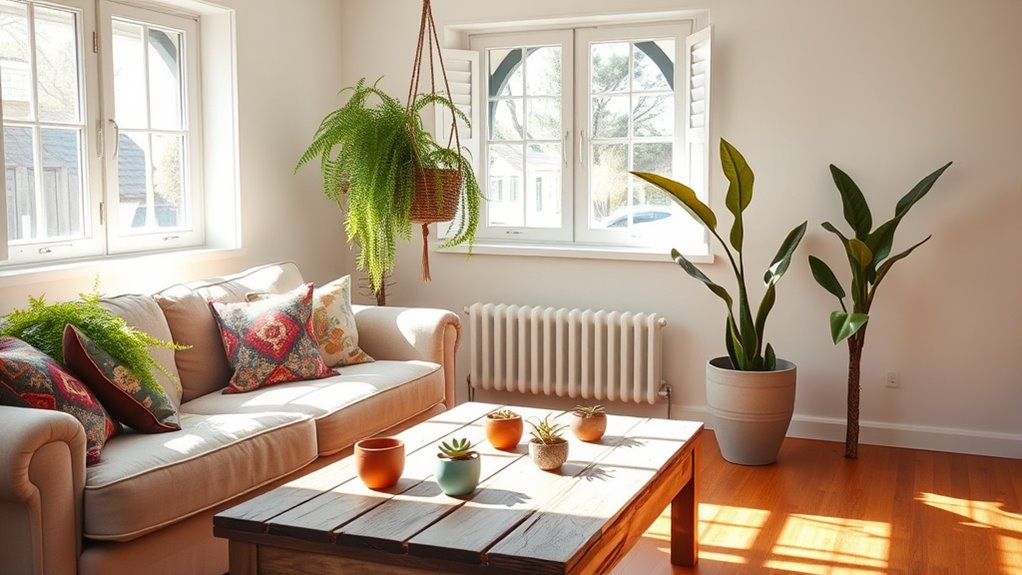
How can you transform your home into a healthier sanctuary? Incorporating indoor plants is a fantastic way to boost wellness and improve air quality.
These green companions reduce stress, enhance creativity, and create a calming atmosphere. Consider adding a Bamboo Palm or Peace Lily to filter out harmful VOCs like formaldehyde and benzene. Furthermore, studies have shown that plants can reduce indoor pollutants and increase humidity, contributing to a more comfortable living environment. Additionally, using heat pumps can further improve indoor air quality by filtering and circulating air effectively. Heat pumps also utilize renewable energy sources, which can enhance the overall sustainability of your home. Adding a backyard greenhouse allows you to grow even more plants, contributing to your indoor environment and overall wellness.
Remember to choose plants that suit your space; some thrive in low light while others need bright conditions. Be mindful of watering needs—overwatering can harm your plants.
Aim for one healthy plant per 100 square feet to maximize air purification benefits. Not only do they purify the air, but they also add natural beauty and texture to your home.
Embrace the vibrant life indoor plants bring!
Frequently Asked Questions
What Are the Benefits of Eco-Friendly Home Decor for My Health?
Eco-friendly home decor significantly benefits your health by using non-toxic materials that reduce exposure to harmful chemicals.
This improvement in indoor air quality can help alleviate respiratory issues and promote overall well-being.
Incorporating natural elements creates a calming environment, reducing stress and boosting your mood.
Plus, using sustainable materials supports a cleaner living space, ensuring a healthier atmosphere for you and your loved ones, particularly for children and pets.
How Can I Identify Sustainable Wood Furniture?
You might think all wood furniture is created equal, but that’s far from the truth.
To identify sustainable wood furniture, check for certifications like FSC or PEFC, showing responsible sourcing. Look for high-quality indicators like a smooth finish and consistent grain.
Ask about the wood’s origin—local is better!
Finally, be wary of greenwashing; brands should provide clear information about their practices.
Your conscious choice makes a difference!
Are There Eco-Friendly Options for Outdoor Decor?
Yes, there are plenty of eco-friendly options for outdoor décor!
You can choose furniture made from recycled plastic or reclaimed wood, which reduces waste. Incorporate natural materials like bamboo and jute for rugs and cushions.
Consider solar-powered lights to minimize energy use. Don’t forget about DIY projects using found objects or thrift store finds to create unique decorations.
These choices help you enjoy your outdoor space while being kind to the environment.
How Can I Maintain My Eco-Friendly Materials?
Maintaining your eco-friendly materials is like nurturing a delicate garden; it requires care and attention.
You’ll want to use gentle, non-toxic cleaners to protect their integrity. Regularly inspect your surfaces, ensuring they remain in top shape, while applying natural finishes to keep them shining.
Don’t forget to ventilate your space, reducing harmful VOCs.
What Are Affordable Eco-Friendly Decor Options for Beginners?
If you’re starting your journey into eco-friendly decor, consider shopping at thrift stores for unique pieces and affordable prices.
You can also get creative with DIY projects, using natural or recycled materials around your home.
Repurposing items, like turning old jars into vases, is both budget-friendly and sustainable.
Incorporate natural elements like branches or seashells to add charm without spending much.
These options help you create a beautiful space while being kind to the environment.
Conclusion
You might think eco-friendly decor is too expensive or complicated, but it doesn’t have to be! Simple choices, like using natural fibers or upcycling items, can save you money and add character to your home. Plus, incorporating energy-efficient lighting and non-toxic paints not only benefits the environment but also creates a healthier space for you and your family. By making these small changes, you can enjoy a beautiful, sustainable home that reflects your values without breaking the bank.
